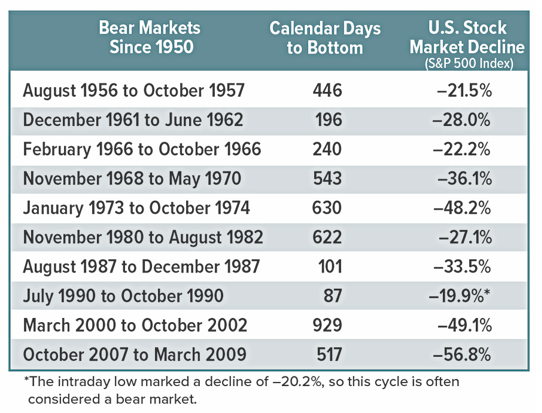Turbulent Times: Bear Markets Come and Go
As markets hit new highs this week, it can be easy to forget that only 9 months ago we were in the middle of a bear market. It took roughly 32 days for the U.S. markets to hit bottom, as the S&P 500 index peaked on February 20, 2020 followed by a steep decline and hitting it’s low in the last weeks of March. Followed by a swift recovery, making this bear market one of the shortest in history, and serving as a reminder that cycles are normal.
We know bear, and bull, markets come and go. Throughout the Bible we see cycles of feast then famine and we know these cycles, of ups and downs, are inevitable (2 Peter 3:4).
As an investor, with a long-term investment strategy you have a better opportunity to ride out these economic cycles. While a shorter time frame usually requires a more conservative approach because you have less time to try to recuperate from a market downturn. So, ask yourself what is your time horizon (the timing in which you need your funds to fulfill a particular goal)? Is cash needed in a lump-sum or is it a multi-year goal, such as retirement income? Can that timing be flexible to allow you to wait out the down turn?
Here’s an article from our newsletter, taking a look at bear markets over time and reminding us that bear markets might be inevitable, but they come and go.
An article from our Newsletter … Bear Markets Come and Go
The longest bull market in history lasted almost 11 years before coronavirus fears and the realities of a seriously disrupted U.S. economy brought it to an end.¹
Bear markets are typically defined as declines of 20% or more from the most recent high, and bull markets are sustained increases of 20% or more from the bear market low. But there is no official declaration, so often there are different interpretations and a fair amount of debate regarding when these cycles begin and end.
Between February 19 and March 23, 2020, the S&P 500 fell 34% and then took just 15 days to bounce back above the 20% threshold that would technically mark the beginning of a new bull market.²
Still, most investors wait to see if volatility subsides and higher prices persist before they cheer the exit of a bear market. And in the midst of the pandemic, without a clear economic picture, it could be more difficult than usual to tell whether any market advance is a short-term rally or the start of a longer upward trend.
Historical Perspective
The CBOE Volatility Index (VIX), a closely watched measure of stock market volatility and investor anxiety, hit all-time highs in March 2020.³
If you are losing sleep over volatility driven by disheartening news, it may help to remember that the economy and the stock market are cyclical. There have been 10 bear markets since 1950 (not counting the one that began in 2020). Each of these declines was triggered by a different set of circumstances, but the market recovered eventually every time (see table). 4
On average, bull markets lasted longer (1,955 days) than bear markets (431 days) over this period, and the average bull market advance (172.0%) was greater than the average bear market decline (-34.2%).
The bottom line is that neither the ups nor the downs last forever, even if they feel as though they will. There are buying opportunities in the midst of the worst downturns. And in some cases, people have profited over time by investing carefully just when things seemed bleakest.
Making Changes
If you're reconsidering your current investment strategy, a volatile market is probably the worst time to turn your portfolio inside out. Dramatic price swings can magnify the impact of a wholesale restructuring if the timing of that move is a little off.
Changes in your portfolio don't necessarily need to happen all at once. Having appropriate asset allocation and diversification is still the fundamental basis of thoughtful investment planning, so try not to let fear derail your long-term goals.
Read more from our quarterly newsletter.
The return and principal value of stocks fluctuate with changes in market conditions. Shares, when sold, may be worth more or less than their original cost. Asset allocation and diversification are methods used to help manage investment risk; they do not guarantee a profit or protect against investment loss. The S&P 500 is an unmanaged group of securities that is considered to be representative of the U.S. stock market in general. The performance of an unmanaged index is not indicative of the performance of any specific investment. Individuals cannot invest directly in an index. Past performance is not a guarantee of future results. Actual results will vary.
1-2,4) Yahoo! Finance, 2020 (data for the period 6/13/1949 to 4/7/2020)
3) MarketWatch, March 31, 2020
Prepared by Broadridge Advisor Solutions Copyright 2020.


